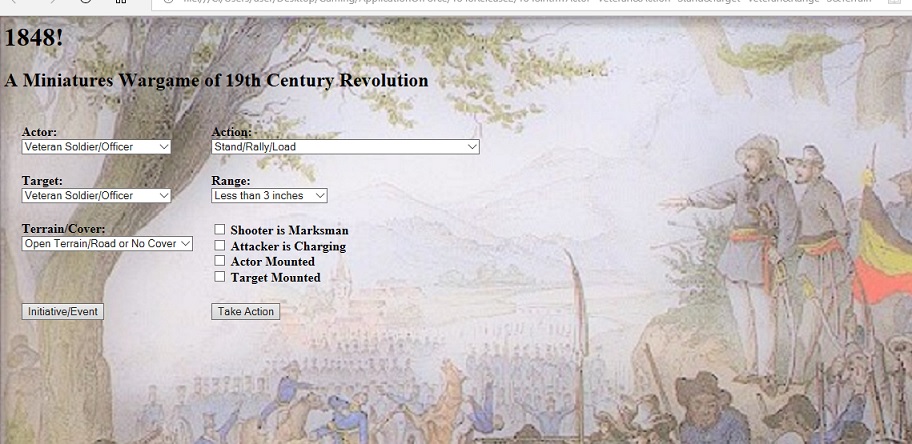
Computer-Assisted Historical Miniatures Wargames
 | Computer-Assisted Historical Miniatures Wargames |
Figure Scale: This game is designed for use with individually based 25mm/28mm miniatures, but can be used with smaller miniatures by adjusting the measurement units for all distances (centimeters instead of inches for 15mm, etc.).
Equipment Needed: A collection of approximately 100 miniatures to cover both player and non-player forces is required (the Rules and Guidelines provides a description of what is needed). Rulers or tape measures in inches are necessary, as is a normal-sized wargames table, and terrain appropriate to the setting of the revolution. No dice are used - all randomization is performed by the app.
Type of Game: This game is designed for cooperative and solo play. Players will take the part of revolutionaries, running a small number of units each made up of 12-24 figures. The game requires a game master to run the app and play the government forces, although it is also good for solo play. Large games (more than 3 or 4 players) may employ a second game master.
Link to App: 1848!
Rules and Guidelines: HTML PDF
While the year 1848 is one familiar to many miniatures wargamers interested in 19th century European history, it is generally associated with the wars fought in Italy (the First Italian War of Independence) and Hungary (the Hungarian Revolution), as both of these provide the set-piece battles between large armies which are the mainstay of 19th-century European historical miniatures gaming. This app provides a way of putting a different kind of action - and one which was much more widespread during that epochal year - on the wargames table. Instead of commanding armies on the battlefield, players command bands of revolutionaries attempting to rouse the populace as they struggle against the oppression of their Absolutist overlords. This is a game where a well-timed speech can do more to ensure victory than a well-timed volley!
As such, it exemplifies how devices and computers can be used to re-frame the type of games we enjoy in our hobby. It is not a purely competitive game, as it places all of the players on one side of the conflict, with the app and the game master providing their opposition. It provides a means of exploring a slightly different type of military history.
Further, it gives wargamers a chance to field some of the more colorful and unusual troops which appeared during the 19th century. Some of the needed figures are likely already in many wargamers' collections: Napoleonic troops as well as figures for European conflicts later in the century may serve to depict the forces of oppression. Revolutionaries are less likely to already have a place in your collection, but figures are available and fun to paint as a change of pace from more usual fare. If you enjoy researching new historical periods and uniforms, and finding figures to match, this game will give you an opportunity to do so. Some suggestions for places to start are provided below.
The game app is used by the game master to moderate all play. It introduces government forces and other tabletop events during play, and allows player forces to make a wide variety of actions. The app itself is fairly simple:

During play, units will act one at a time in response to a randomized initiative (the "Initiative/Event" button) which also serves to trigger tabletop events. All consequent actions (fire, movement, melee, searching structures, construction/destruction, and impassioned revolutionary oratory, etc.) are conducted using the "Take Action" button and other app fields, as appropriate. Because the game does not involve learning a lot of complex mechanics, it is easy to pick up. With a good game master, it plays as fast or faster than most similar miniatures games.
Figures for government forces are easy to come by: in 1848, some nations were still using their Napoleonic kit, while others were in later uniforms, and many both at the same time (it was a transitional period). For later-period figures, a listing is available. Figures for depicting revolutionaries are harder to find. For some types, the Chouans produced by Trent miniatures may prove useful. Steve Barber has an excellent line. My favorites for the more professional style of revolutionary are Gringo 40s Garibaldini, which also has some really useful Neapolitan troops. (I usually run games depicting the revolution in Baden, and the Garibaldini style was copied by many of the German revolutionaries.)
Non-combatant figures and armed civilians are needed, and these may be a bit harder to find. For aristocrats, there are excellent Napoleonic civilians produced by Front Rank (now Gripping Beast). Perry Miniatures produces some really useful rioters (and also here, here, and here.) from the 1860s in their ACW line. And Wargames Foundry makes all kinds of useful stuff (including a must-have figure of Liberty). The 19th century civilians are worth a look, too. Their spin-off line of Casting Room Miniatures also has a useful bunch of revolutionaries.
Uniform information is not always easy to come by for this ´period, but one priceless resource can be found at the New York Public Libraries site. Some additional reference material is listed here.